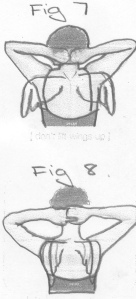In order to fully benefit from the Pilates system, it is essential to commit to a regular practice routine as well as examine you currently lifestyle. Be prepared to make changes where necessary. Make sure you get enough rest and eat a healthy diet while reducing your stress levels and staying positive.
In the next few Articles I will be going through some valuable information to help you lead the healthy life you want.
For most people today a serious concern is that of weight loss. There are so many “wonder” diets promising you massive weight loss in a short time and this setting unrealistic goals for those who want to lose the weight and keep it off. As such when these unrealistic rapid results are not met, we tend to give up . Trapping ourselves in a never ending cycle of unhealthy habits.
The trick here is to set realistic goals. Unless you are working out intensely for at least 4hrs a day, it is highly unlikely you will lose up to 10Lbs per week! You would also have to be eating way below your usual caloric intake which in turn will “starve” your body and so when you end your “diet” , your body will automatically store the extra “fuel” and this will make you gain more weight in the long run.
Theoretically , if you are burning more calories than you are taking in you should lose weight. Most of us can attest to the fact that this is not as simple as it seems.
Here are some hints to help you :
Calorie counting: First of all you will need to figure out your Resting Metabolic Rate. (RMR) . Use this link:
http://www.shapefit.com/basal-metabolic-rate.html
The number you get will represent the minimum number of calories you need to maintain your current weight. It is believed that in order to lose weight you need to diet or exercise up to a 500 caloric deficit everyday. This means you either have to exercise 500 calories off or eat 500 calories less than your minimum requirement.
Personally I recommend increasing you activity levels , it is important to figure out what you Maximum heart rate would be. Use this formula : 208 -( 0.7x age) = Max heart rate.
This will help you to figure out your Target heart rate in order to determine your ideal heart rate( while exercising ) for weight loss. A good target is to aim for between 50% and 70% of you maximum heart rate. ( Times your heart rate by 0.5 or 0.7) . This is useful if you are using a heart rate monitor ( which can be bought in most stores) or using the monitors attached to various cardio machines at the GYM.
unfortunately for women , without exercise once we are over 25yrs old, we lose lean muscle and replace it with body fat. At a rate of up to 3% per year. Excessive body fat – particularly in the abdomen – is a high risk factor for killers such as heart disease and diabetes.
I recommend doing exercise at least 4 x a week for up to an hour . Cardio twice weekly and a strengthening and toning exercise ( Pilates is perfect for this! ) at least twice a week too. Of course the more you exercise the faster you will get better results.
On days you do not exercise drop you calorie intake, and do the little things necessary for maintaining an active lifestyle.





